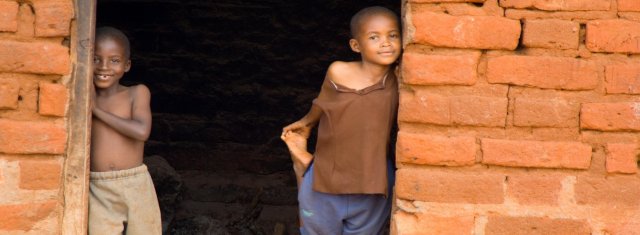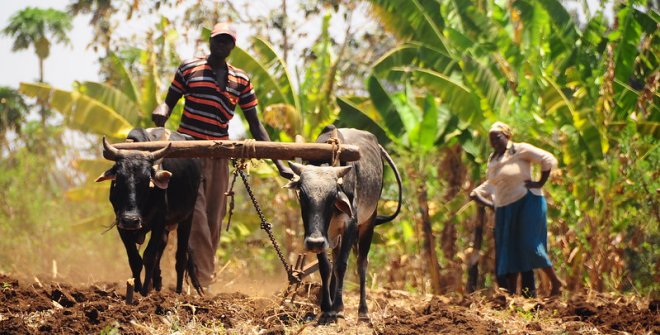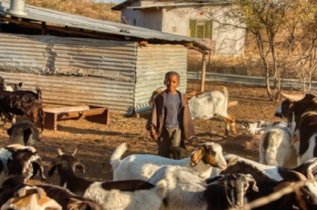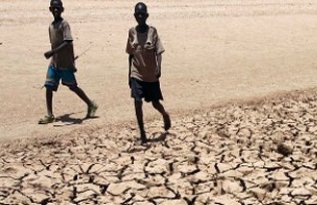|
Women often rise first, preparing the morning meal, typically uji (porridge) or leftovers from the previous evening, and fetching water from a communal well or river, a task that can consume several hours. Children, after their morning duties, embark on the journey to school, often walking several kilometres. Men, meanwhile, tend to livestock, prepare tools for farming, or head out to work in nearby fields, whether their own or those of others.
Whether in a city apartment or a rural homestead, at the heart of Kenyan life is the concept of family. The family unit extends far beyond the nuclear structure common in Western cultures; it is an expansive network of parents, children, grandparents, aunts, uncles, and cousins who form a powerful support system. In a Kenya village, this extends even further as children aren't just raised by their parents and their extended family, but by the entire community iself. Respect for elders is a deeply ingrained value, and their wisdom is often sought in matters of importance. This extended family structure provides social and economic security, ensuring that individuals are cared for from birth to old age. Major life events are communal affairs, celebrated with the entire extended family and community, reinforcing the bonds that hold the society together.
Outside city areas, food, the most basic sustenance, is predominantly grown by the villagers themselves as it isn't available in supermarkets. The undisputed national dish is Ugali, a dense porridge made from maize flour, which is served with nearly every meal. It is typically accompanied by a vegetable stew, such as Sukuma Wiki (a dish of sweet potato or pumpkin leaves) and a protein, often a savoury meat stew or, for better off families, roasted goat or mutton meat known as Nyama Choma. Other staples include Githeri (a mixture of boiled maize and beans), rice, and Chapati - a flaky flatbread with Indian origins. Additional foodstuffs are bought and sold at a weekly or sometimes bi-weekly market. Food preparation is often a communal effort, especially for larger families, and meals are shared, symbolising unity and hospitality. Making hot meals isn't simply a matter of turning on the oven as rural electricity access in Kenya significantly lags urban areas, with around 37% of the rural population lacking reliable electricity, compared to full access (when affordable) in urban centres. While the national grid now serves almost 90% of the country, over 40% of Kenyans still use off-grid sources, mostly solar. Challenges to a wider grid roll-out include infrastructure limitations, affordability, and the need for robust policy to connect remaining rural populations and integrate renewable energy. Kenya's goal is 100% universal access by 2030, utilising the Last Mile Connectivity Project and off-grid solutions. In rural villages, as the kitchen area of the home (which is normally constructed of wood then finished off with mud) doesn't actually have a stove, cooking is undertaken with charcoal or paraffin over stones on the bare floor, with the resulting smoke permeating the entire home, even with the windows (or rather shutters) open.
This blend of old and new is also evident in the persistence of cultural rituals for life in Kenya. With over 40 distinct ethnic groups, the country boasts a diversity of traditions. Rites of passage, such as initiation ceremonies marking the transition from childhood to adulthood, remain significant in many communities, including the Maasai and Kikuyu. Marriage, too, is steeped in tradition, often involving intricate negotiations and the payment of a bride price (ruracio in Kikuyu), a practice that solidifies the bond between two families. While modernisation has altered some of these customs, they continue to be a vital part of cultural identity. Many in Kenya are reliant on impoverished subsistence farming that, coupled with poor healthcare resources (one doctor per 5,725 people nationally in 2025, a figure significantly lower than the WHO-recommended ratio of 1:1,000). This drives many into further poverty as income drops when the family earner becomes ill when suffering from HIV (the adult HIV prevalence rate is approximately 3.7% in adults aged 15-49 years), water borne diseases and malaria.
Today Kenya is classified as a chronologically water-scarce country due to its arid climate, limited freshwater endowments, and the increasing strain of climate change on its water resources with over 80% of the land classified as arid or semi-arid, limiting its freshwater potential. Mainly women and children often have to walk 3-4 hours a day to collect unsafe water from shallow wells, taking them away from other domestic duties and/or education. (In the hardest hit areas water is some 12-19 miles away.) The situation for those living in urban situations is not much better with water being expensive and sanitation poor. In slums such as Kibera in Nairobi, water costs three shillings for each 20 litres ~ just over 2p, but a lot from a limited income. Be mindful that the average person in England and Wales uses 150 litres of water a day, that's per person, not per family, and the average household size in Kenya is 3.8 people according to recent data from 2023, again higher in rural, village areas. |
Life in Kenya |
Life in Kenya |
Life in Kenya | Life in Kenya |
|
 |

|
These droughts are compounded by rapid deforestation and poor land management and farming techniques with the lack of rainfall leading to crop failure and livestock death. Animals that have survived, such as cows, are either too thin to sell or are unable to produce milk with the typical price of a cow dropping from about 40,000 Kenyan shillings (257UK) to 5,000 KSH (32UK) in just months. As a result, many families have been forced to abandon their homes in search of food and water, impacting both pastoralist and agricultural communities. This lack of food has led to conflict in some areas as villagers find themselves in dispute with their neighbours to secure grazing areas for the livestock. This situation is part of a larger food crisis in East Africa, where climate-related factors have led to widespread food insecurity for millions.
As can be seen, despite its beauty and cultural richness, life in Kenya faces formidable challenges. Economic inequality is a major issue, creating a vast gap between a small, affluent elite and the majority of the population who struggle with poverty and unemployment, particularly among the youth. The video (above, left) provides further insights into daily life in Kenya.
|

 Village schools are rudimentary with desks, chairs blackboards and pencils but no real equipment nor electricity. Children attend primary school until they are 13-14yrs old before taking the Kenya Certificate of Primary Education which informs whether they should attend high school or go onto training. However the reality is that most children will drop out of education at this stage for, whilst primary schooling is free, high school is not and beyond the financial reach of many Kenyan villagers costing as much as the equivalent of nine month's income every year. Boys who drop out will go out to work with their fathers whilst some girls are married off as young as 12-14yrs to reduce the family burden.
Village schools are rudimentary with desks, chairs blackboards and pencils but no real equipment nor electricity. Children attend primary school until they are 13-14yrs old before taking the Kenya Certificate of Primary Education which informs whether they should attend high school or go onto training. However the reality is that most children will drop out of education at this stage for, whilst primary schooling is free, high school is not and beyond the financial reach of many Kenyan villagers costing as much as the equivalent of nine month's income every year. Boys who drop out will go out to work with their fathers whilst some girls are married off as young as 12-14yrs to reduce the family burden. Religion also plays a central and highly visible role in the life of most Kenyans. The nation is predominantly Christian, with over 85% of the population identifying with various denominations from Catholic to Protestant and Evangelical churches. Sunday mornings are marked by lengthy church services filled with music, dance, and passionate sermons. Islam has a strong presence as well, particularly in the coastal regions and northeastern parts of the country. Alongside these major religions, traditional indigenous beliefs continue to hold influence, often blending with Christian or Islamic practices. For many, faith is not just a private matter but a guiding principle that shapes their worldview, moral compass, and daily interactions.
Religion also plays a central and highly visible role in the life of most Kenyans. The nation is predominantly Christian, with over 85% of the population identifying with various denominations from Catholic to Protestant and Evangelical churches. Sunday mornings are marked by lengthy church services filled with music, dance, and passionate sermons. Islam has a strong presence as well, particularly in the coastal regions and northeastern parts of the country. Alongside these major religions, traditional indigenous beliefs continue to hold influence, often blending with Christian or Islamic practices. For many, faith is not just a private matter but a guiding principle that shapes their worldview, moral compass, and daily interactions. Housing in Kenya reflects the country's economic diversity. In the cities, everything can be found from luxurious villas in gated communities to modern apartment blocks. However, these exist alongside vast informal settlements, such as Nairobi's Kibera, where millions live in makeshift homes made of corrugated iron sheets and face significant challenges with sanitation and basic services (see our separate Kibera article on our main Kenya profile page.). In rural areas, traditional housing is constructed from locally sourced materials like mud, cow dung, and thatched roofs (left). While these structures are still common, there is a growing trend towards building more permanent homes with stone walls and metal tin roofs. These structures, while seemingly simple, are robust and adapted to the local climate. They are often arranged within a homestead, or boma, which might include several small dwellings for different family members, a cooking area, and enclosures for livestock.
Housing in Kenya reflects the country's economic diversity. In the cities, everything can be found from luxurious villas in gated communities to modern apartment blocks. However, these exist alongside vast informal settlements, such as Nairobi's Kibera, where millions live in makeshift homes made of corrugated iron sheets and face significant challenges with sanitation and basic services (see our separate Kibera article on our main Kenya profile page.). In rural areas, traditional housing is constructed from locally sourced materials like mud, cow dung, and thatched roofs (left). While these structures are still common, there is a growing trend towards building more permanent homes with stone walls and metal tin roofs. These structures, while seemingly simple, are robust and adapted to the local climate. They are often arranged within a homestead, or boma, which might include several small dwellings for different family members, a cooking area, and enclosures for livestock. While nearly 40% of Kenyans were living below the poverty line in 2022, this represents a significant improvement from the roughly 47% in 2006. However, economic factors including corruption, inequality, and high unemployment remain challenges that contribute to widespread poverty despite overall economic growth. Another factor is that Kenya has seen its population triple in just 30 years placing a burden on available land and already poor resources such as water with 15% of Kenyans relying on unimproved water sources such as ponds, shallow wells and rivers for their supply, while 41% lack access to basic sanitation solutions. This figures are higher in rural, village areas. The water situation in Kenya is compounded by the worst drought conditions for sixty years which are sweeping across the Horn of Africa from Djibouti where thousands of animals are dying with Nomads driven from their lands across Somalia and into eastern Kenya.
While nearly 40% of Kenyans were living below the poverty line in 2022, this represents a significant improvement from the roughly 47% in 2006. However, economic factors including corruption, inequality, and high unemployment remain challenges that contribute to widespread poverty despite overall economic growth. Another factor is that Kenya has seen its population triple in just 30 years placing a burden on available land and already poor resources such as water with 15% of Kenyans relying on unimproved water sources such as ponds, shallow wells and rivers for their supply, while 41% lack access to basic sanitation solutions. This figures are higher in rural, village areas. The water situation in Kenya is compounded by the worst drought conditions for sixty years which are sweeping across the Horn of Africa from Djibouti where thousands of animals are dying with Nomads driven from their lands across Somalia and into eastern Kenya.



 Climate change means the dry spells in this part of northern Kenya are likely to be ongoing, more frequent and worse. Although the area is home to Lake Turkana, that is a saltwater lake meaning its water is undrinkable. Instead locals, in the absence of any meaningful rainfall, have to rely on boreholes for their water but, with no real irrigation systems, that cannot sustain food production and the water table continues to shrink. With a growing population in Kenya there will be even less water available in future years. Ironically the aridness of the soil has led to flash floods as when rain finally does fall, the land cannot absord the water, destroying what few crops are growing at this time, stoking up more problems for the years to come. The infographic below demonstrates the food crisis across the Horn of Africa in stark detail with much of the area being defined as 'emergency', 'stressed' or in 'crisis'.
Climate change means the dry spells in this part of northern Kenya are likely to be ongoing, more frequent and worse. Although the area is home to Lake Turkana, that is a saltwater lake meaning its water is undrinkable. Instead locals, in the absence of any meaningful rainfall, have to rely on boreholes for their water but, with no real irrigation systems, that cannot sustain food production and the water table continues to shrink. With a growing population in Kenya there will be even less water available in future years. Ironically the aridness of the soil has led to flash floods as when rain finally does fall, the land cannot absord the water, destroying what few crops are growing at this time, stoking up more problems for the years to come. The infographic below demonstrates the food crisis across the Horn of Africa in stark detail with much of the area being defined as 'emergency', 'stressed' or in 'crisis'.



